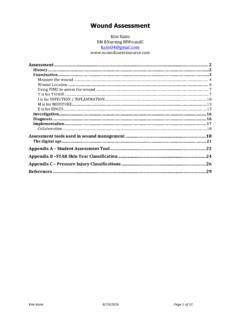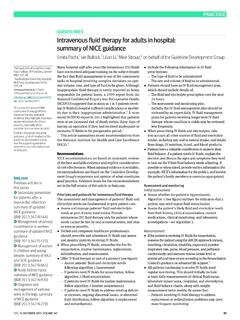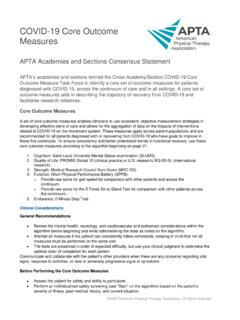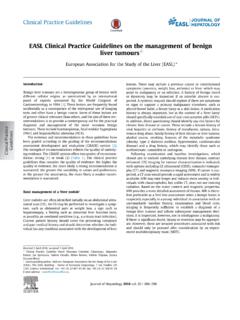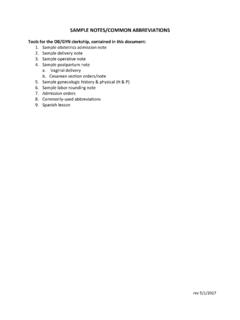Transcription of Potassium Disorders: Hypokalemia and Hyperkalemia
1 September 15, 2015 Volume 92, Number 6 American Family Physician 487 Hypokalemia and Hyperkalemia are common electrolyte disorders caused by changes in Potassium intake, altered excretion, or transcellular shifts. Diuretic use and gastrointestinal losses are common causes of Hypokalemia , whereas kidney disease, hyperglycemia, and medication use are common causes of Hyperkalemia . When severe, Potassium disorders can lead to life-threatening cardiac conduction disturbances and neuromuscular dysfunction. Therefore, a first priority is determining the need for urgent treatment through a combination of history , physical examination , laboratory, and electrocardiography findings. Indications for urgent treatment include severe or symptomatic hypo-kalemia or Hyperkalemia ; abrupt changes in Potassium levels; electrocardiography changes; or the presence of certain comorbid conditions.
2 Hypokalemia is treated with oral or intravenous Potassium . To prevent cardiac conduction dis-turbances, intravenous calcium is administered to patients with hyperkalemic electrocardiography changes. Insulin, usually with concomitant glucose, and albuterol are preferred to lower serum Potassium levels in the acute setting; sodium polystyrene sulfonate is reserved for subacute treatment. For both disorders, it is important to consider poten-tial causes of transcellular shifts because patients are at increased risk of rebound Potassium disturbances. (Am Fam Physician. 2015;92(6):487- 495. Copyright 2015 American Academy of Family Physicians.) Potassium Disorders: Hypokalemia and HyperkalemiaANTHONY J. VIERA, MD, MPH, and NOAH WOUK, MD, University of North Carolina at Chapel Hill School of Medicine, Chapel Hill, North CarolinaPotassium disorders are common.
3 Hypokalemia (serum Potassium level less than mEq per L [ mmol per L]) occurs in up to 21% of hospitalized patients and 2% to 3% of Hyperkalemia (serum potas-sium level more than 5 mEq per L [5 mmol per L] in adults, more than mEq per L [ mmol per L] in children, and more than 6 mEq per L [6 mmol per L] in neonates) occurs in up to 10% of hospitalized patients and approximately 1% of ,5 The body s plasma Potassium concentration is closely regulated by a variety of of HypokalemiaHypokalemia results from abnormal losses, transcellular shifts, or insufficient intake (Ta b l e 1).6-8 Abnormal losses are most Because the kidney can significantly lower Potassium excretion in response to decreased intake, insufficient intake is rarely the sole cause of Hypokalemia , but it often contrib-utes to Hypokalemia in hospitalized LOSSESD iuretic use is a common cause of renally mediated When given in the same dosage, chlorthalidone is more likely to induce Hypokalemia than hydrochlorothia-zide, which is more often implicated because of its widespread ,12 Diuretic-induced Hypokalemia is dose-dependent and tends to be mild (3 to mEq per L [3 to mmol per L]), although it can be more severe when accompanied by other causes ( , gastroin-testinal [GI] losses).
4 13GI LOSSESGI losses are another common cause of Hypokalemia , particularly among hospital-ized The mechanism by which upper GI losses induce Hypokalemia is indi-rect and stems from the kidney s response to the associated alkalosis. As a portion of daily Potassium is excreted in the colon, lower GI losses in the form of persistent diarrhea can also result in Hypokalemia and may be accompanied by hyperchloremic and Management of HypokalemiaGENERAL PRINCIPLESH ypokalemia is often asymptomatic. Evalu-ation begins with a search for warning signs or symptoms warranting urgent treatment More online at This clinical content conforms to AAFP criteria for continuing medical education (CME). See CME Quiz Questions on page 4 disclosure: No rel-evant financial affiliations.
5 Patient information: A handout on this topic, written by the authors of this article, is available at / 2015 / 0915 / p4 from the American Family Physician website at Copyright 2015 American Academy of Family Physicians. For the private, noncom-mercial use of one individual user of the website. All other rights reserved. Contact for copyright questions and/or permission Disorders488 American Family Physician Volume 92, Number 6 September 15, 2015(Figure 1) .7,14 These include weakness or pal-pitations, changes on electrocardiography (ECG), severe Hypokalemia (less than mEq per L [ mmol per L]), rapid-onset Hypokalemia , or underlying heart disease or ,15 Most cases of Hypokalemia -induced rhythm disturbances occur in individuals with underlying heart Early identification of transcellular shifts is important because management may differ.
6 Identification and treatment of concurrent hypomagnesemia are also important because magnesium depletion impedes Potassium repletion and can exacerbate Hypokalemia -induced rhythm ,17 history AND PHYSICAL EXAMINATIONA focused history includes evaluation for possible GI losses, review of medications, and assessment for underlying cardiac comorbidities. A history of paralysis, hyper-thyroidism, or use of insulin or beta agonists suggests possible transcellular shifts leading to redistributive Hypokalemia . The physical examination should focus on identifying cardiac arrhythmias and neurologic mani-festations, which range from generalized weakness to ascending ANALYSIS AND ECGThe diagnosis should be confirmed with a repeat serum Potassium measurement.
7 Other laboratory tests include serum glucose and magnesium levels, urine electrolyte and creatinine levels, and acid-base balance. The most accurate method for evaluating urinary Potassium excre-tion is a 24-hour timed urine Potassium collection; nor-mal kidneys excrete no more than 15 to 30 mEq per L (15 to 30 mmol per L) of Potassium per day in response to Hypokalemia . A more practical approach is calculation of the urine Potassium -to-creatinine ratio from a spot urine specimen; a ratio greater than mEq per mmol (13 mEq per g) is indicative of renal Potassium If no cause is identified with the initial workup, assessment of thyroid and adrenal function should be , the first ECG manifestation of hypokale-mia is decreased T-w a v e amplitude.
8 Further progression can lead to S T-i nt e r v a l depression, T-w a v e inversions, PR-interval prolongation, and U waves. Arrhythmias associated with Hypokalemia include sinus bradycar-dia, ventricular tachycardia or fibrillation, and torsade de Although the risk of ECG changes and arrhythmias increases as serum Potassium concentra-tion decreases, these findings are not reliable because some patients with severe Hypokalemia do not have ECG of HypokalemiaThe immediate goal of treatment is the prevention of potentially life-threatening cardiac conduction distur-bances and neuromuscular dysfunction by raising serum Potassium to a safe level. Further replenishment can pro-ceed more slowly, and attention can turn to the diagnosis and management of the underlying Patients with a history of congestive heart failure or myocardial infarction should maintain a serum Potassium concen-tration of at least 4 mEq per L (4 mmol per L), based on expert monitoring during treatment is essential because supplemental Potassium is a common cause of Hyperkalemia in hospitalized The risk of rebound Hyperkalemia is higher when treating redis-tributive Hypokalemia .
9 Because serum Potassium con-centration drops approximately mEq per L ( mmol per L) for every 100-mEq (100-mmol) reduction in total body Potassium , the approximate Potassium Table 1. Causes of HypokalemiaAbnormal lossesMedicationsDiureticsLaxatives and enemasCorticosteroidsGastrointestinal lossesRenal lossesOsmotic diuresisMineralocorticoid excessTypes I and II renal tubular acidosisPolydipsiaIntrinsic renal transport defectsHypomagnesemiaDialysis/plasmapher esisTranscellular shiftsMedicationsInsulin overdoseBeta2 sympathomimeticsDecongestantsXanthinesAm photericin BVerapamil intoxicationChloroquine (Aralen) intoxicationBarium intoxicationCesium intoxicationNOTE: Listed in approximate order of from references 6 through shifts (continued)AlkalosisRefeeding syndromeIncreased beta2 adrenergic stimulationDelirium tremensHead injuryMyocardial ischemiaThyrotoxicosisFamilial hypokalemic periodic paralysisHypothermiaInadequate intakeAnorexiaDementiaStarvationTotal parenteral nutritionPseudohypokalemiaDelayed sample analysisSignificant leukocytosis (> 75,000 cells per mm3 [ 109 per L]) Potassium DisordersSeptember 15, 2015 Volume 92, Number 6 American Family Physician 489deficit can be estimated in patients with abnormal losses and decreased intake.
10 For example, a decline in serum Potassium from to mEq per L ( to mmol per L) roughly corresponds to a 300-mEq (300-mmol) reduc-tion in total body Potassium . Additional Potassium will be required if losses are ongoing. Concomitant hypomag-nesemia should be treated Hypokalemia associated with diuretic use, stopping the diuretic or reducing its dosage may be Another strategy, if otherwise indicated to treat a comor-bid condition, is use of an angiotensin-converting enzyme (ACE) inhibitor, angiotensin receptor blocker (ARB), beta blocker, or Potassium -sparing diuretic because each of these drugs is associated with an elevation in serum Potassium . It is appropriate to increase dietary po tassium in patients with low-normal and mild Hypokalemia , particularly in those with a history of hypertension or heart The effectiveness of increased dietary Potassium is limited, however, because most of the Potassium contained in foods is coupled with phosphate, whereas most cases of Hypokalemia involve chloride depletion and respond best to supplemen-tal Potassium ,15 Because use of intravenous Potassium increases the risk of Hyperkalemia and can cause pain and phlebitis, intravenous Potassium should be reserved for patients with severe Hypokalemia , hypokalemic ECG changes, or physical signs or symp-toms of Hypokalemia .










